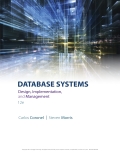
Concept explainers
“GROUP BY” Clause:
The GROUP BY clause is used to group the result of a SELECT statement done on a table where the tuple values are similar for more than one column.
Syntax:
SELECT expression1, expression2, expression_n, aggregate_function (expression) FROM table_name WHERE conditions GROUP BY expression1, expression2, expression_n;
DISTINCT Keyword: “DISTINCT” keyword is used to avoid redundant data (removing duplicate values) from a column. The syntax for “DISTINCT” keyword is as follows:
Syntax:
SELECT DISTINCT column_Name FROM table_Name;
Join: Join is a relational operation, which combines the data from two or more tables into single table or view, then that is called as Join.
Inner join: The “inner join” keyword is to select the matching records from two tables. The syntax of “inner join” is as follows:
Syntax:
SELECT column_name FROM table1 INNER JOIN table2 ON table1.column_name=table2.column_name;
Trending nowThis is a popular solution!

Chapter 7 Solutions
EBK DATABASE SYSTEMS: DESIGN, IMPLEMENT
- Given the schema below for the widgetshop, provide a schema diagram. Schema name Attributes Widget-schema Customer-schema (stocknum, manufacturer, description, weight, price, inventory) (custnum, name, address) Purchased-schema (custnum, stocknum, pdate) Requestedby-schema (stocknum, custnum) Newitem-schema (stocknum, manufacturer, description) Employee-schema (ssn, name, address, salary) You can remove the Newitem-schema (red).arrow_forwardTrue or False: Given the sets F and G with F being an element of G, is it always ture that P(F) is an element of P(G)? (P(F) and P(G) mean power sets). Why?arrow_forwardCan you please simplify (the domain is not empty) ∃xF (x) → ¬∃x(F (x) ∨ ¬G(x)). Foarrow_forward
- HistogramUse par(mfrow=c(2,2)) and output 4 plots with different argument settings.arrow_forward(use R language)Scatter plot(a). Run the R code example, and look at the help file for plot() function. Try different values for arguments:type, pch, lty, lwd, col(b). Use par(mfrow=c(3,2)) and output 6 plots with different argument settings.arrow_forward1. Draw flow charts for each of the following;a) A system that reads three numbers and prints the value of the largest number.b) A system reads an employee name (NAME), overtime hours worked (OVERTIME), hours absent(ABSENT) and determines the bonus payment (PAYMENT).arrow_forward
- Scenario You work for a small company that exports artisan chocolate. Although you measure your products in kilograms, you often get orders in both pounds and ounces. You have decided that rather than have to look up conversions all the time, you could use Python code to take inputs to make conversions between the different units of measurement. You will write three blocks of code. The first will convert kilograms to pounds and ounces. The second will convert pounds to kilograms and ounces. The third will convert ounces to kilograms and pounds. The conversions are as follows: 1 kilogram = 35.274 ounces 1 kilogram = 2.20462 pounds 1 pound = 0.453592 kilograms 1 pound = 16 ounces 1 ounce = 0.0283 kilograms 1 ounce = 0.0625 pounds For the purposes of this activity the template for a function has been provided. You have not yet covered functions in the course, but they are a way of reusing code. Like a Python script, a function can have zero or more parameters. In the code window you…arrow_forwardmake a screen capture showing the StegExpose resultsarrow_forwardWhich of the following is not one of the recommended criteria for strategic objectives? Multiple Choice a) realistic b) appropriate c) sustainable d) measurablearrow_forward
- Management innovations such as total quality, benchmarking, and business process reengineering always lead to sustainable competitive advantage because everyone else is doing them. a) True b) Falsearrow_forwardVision statements are more specific than strategic objectives. a) True b) Falsearrow_forwardThe three components of the __________ approach to corporate accounting include financial, environmental, and social performance measures. Multiple Choice a) stakeholder b) triple dimension c) triple bottom line d) triple efficiencyarrow_forward

 A Guide to SQLComputer ScienceISBN:9781111527273Author:Philip J. PrattPublisher:Course Technology Ptr
A Guide to SQLComputer ScienceISBN:9781111527273Author:Philip J. PrattPublisher:Course Technology Ptr Database Systems: Design, Implementation, & Manag...Computer ScienceISBN:9781305627482Author:Carlos Coronel, Steven MorrisPublisher:Cengage Learning
Database Systems: Design, Implementation, & Manag...Computer ScienceISBN:9781305627482Author:Carlos Coronel, Steven MorrisPublisher:Cengage Learning- Np Ms Office 365/Excel 2016 I NtermedComputer ScienceISBN:9781337508841Author:CareyPublisher:Cengage




